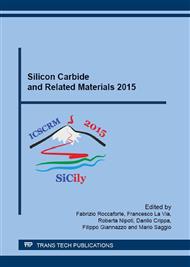[1]
S. E. Saddow, Ed., Silicon Carbide Biotechnology: A Biocompatible Semiconductor for Advanced Biomedical Devices and Applications. Amsterdam: Elsevier, 2011, p. ^pp. Pages.
Google Scholar
[2]
M. Reyes, C. Frewin, P. J. Ward, and S. E. Saddow, 3C-SiC on Si Hetero-Epitaxial Growth for Electronic and Biomedical Applications, ECS Transactions, vol. 58, pp.119-126, (2013).
DOI: 10.1149/05804.0119ecst
Google Scholar
[3]
C. Iliescu and D. P. Poenar, PECVD Amorphous Silicon Carbide (a-SiC) Layers for MEMS Applications, in Physics and Technology of Silicon Carbide Devices, Y. Hijikata, Ed., ed Rijeka, Croatia: InTech, 2013, pp.131-148.
DOI: 10.5772/51224
Google Scholar
[4]
L. L. Hench and J. Wilson, Biocompatibility of silicates for medical use, " in Ciba Foundation Symposium - Silicon Biochemistry. vol. 121, D. Evered and M. O, Connor, Eds., ed Chichester, UK: John Wiley & Sons, 1986, p.231 – 253.
DOI: 10.1002/9780470513323.ch14
Google Scholar
[5]
C. L. Frewin, C. Locke, L. Mariusso, E. J. Weeber, and S. E. Saddow, Silicon Carbide Neural Implants: in vivo Neural Tissue Reaction, Neural Engineering (NER), 6th International IEEE/EMBS Conference on, pp.661-664, (2013).
DOI: 10.1109/ner.2013.6696021
Google Scholar
[6]
S. Afroz, S. W. Thomas, G. Mumcu, and S. E. Saddow, Implantable SiC based RF antenna biosensor for continuous glucose monitoring, in IEEE Sensors, Baltamore, Maryland USA, (2013).
DOI: 10.1109/icsens.2013.6688379
Google Scholar
[7]
C. Hehrlein, Stent Passivation with Silicon Carbide as a Possible Alternative to Drug-eluting Stents - A Comprehensive Review of Pre-clinical and Clinical Results, Interventional Cardiology Review, vol. 4, pp.60-63, (2009).
DOI: 10.15420/icr.2009.4.1.60
Google Scholar
[8]
C. G. Welle and V. Krauthamer, FDA Regulation of Invasive Neural Recording Electrodes: A Daunting Task for Medical Innovators, Pulse, IEEE, vol. 3, pp.37-41, (2012).
DOI: 10.1109/mpul.2011.2181022
Google Scholar
[9]
M. Jorfi, J. L. Skousen, C. Weder, and J. R. Capadona, Progress towards biocompatible intracortical microelectrodes for neural interfacing applications, Journal of Neural Engineering, vol. 12, p.011001, (2015).
DOI: 10.1088/1741-2560/12/1/011001
Google Scholar
[10]
C. W. Locke, Stress-Strain Management of Heteroepitaxial Polycrystalline Silicon Carbide Films, Ph.D., Electrical Engineering, University of South Florida, Tampa, Florida, (2011).
Google Scholar
[11]
M. Gazziro, C. F. R. Braga, D. A. Moreira, A. C. P. L. F. Carvalho, J. F. Rodrigues, J. S. Navarro, et al., Transmission of wireless neural signals through a 0. 18µm CMOS low-power amplifier, presented at the 37th IEEE Engineering in Medicine and Biology Society, Milan, Italy, (2015).
DOI: 10.1109/embc.2015.7319537
Google Scholar
[12]
C. M. Company. (2012). Product Outline: CM911ff – UHF Passive RFID Front-End, EPCGlobal Class 1 Gen 2/ISO18000-6C Compliant. Available: http: /www. chipus-ip. com/pdf/CM9011ff_outline_rev1v0. pdf.
Google Scholar


